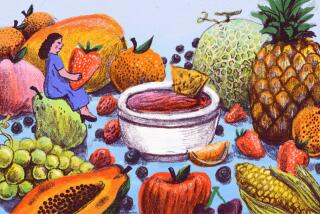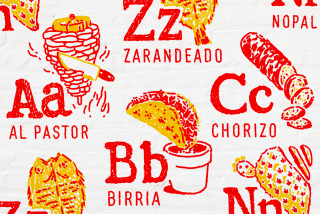How to grow tomatillos
- Share via
Long before the tomato achieved star status in the vegetable gardening world, its cousin in the nightshade family, the tomatillo (Physalis philadelphica), was a staple for the people of Mexico and Guatemala. One tomatillo plant can pump out more than 10 pounds of fruit, each neatly wrapped in its own protective packaging.
The tomatillo is high in potassium, calcium and folic acid. A half-cup of fruit has 15% of your daily vitamin C.
In Echo Park, singer Weba Garretson is growing tomatillos for the first time, using a bed where she had grown tomatoes.
“They’re doing really well,” she said. “I roast them under the broiler, in the paper. I take the papers off and puree the fruit with roasted serrano chiles and garlic. I use that sauce with meat, fish, chicken. It’s really good with pork.”
The classic salsa verde recipe is just one use for the fruit. Diced tomatillos can go into stews, moles and soups, thickening as they cook. Diced and added raw to guacamole, tomatillos bring a subtle tart crunchiness that contrasts nicely with the smooth sweetness of avocados. They pair well with mild or hot chiles.
Tomatillo plants ramble and can reach 3 feet tall quickly, so stake them young, just like a tomato. Tomatillo plants like well-drained soil and consistent watering, and they do fine in containers as long as they get full sun.
They are not self-pollinating, so you must have at least a couple of plants relatively close to one another to get fruit. The tiny yellow flowers are bee magnets, so you don’t have to rely on just the wind to fertilize the flowers.
If tomatillos are overcrowded, they can get a powdery mildew, especially when the weather gets hot and humid. Overhead watering also contributes to this airborne fungal disease.
One possible solution: spraying affected leaves and fruit with a 50-50 solution of nonfat milk and water, or a weak dilution of baking soda in water (1 teaspoon of baking soda to 1 quart of water). Heavily diseased plants should be removed. Do not add them to the compost pile; throw them in the trash.
Tomatillos are ripe when the paper husk begins to split, but sometimes this never happens. Depending on the coolness of the summer, you might have to wait 100 days until harvest. You can wait for the fruit to drop on the ground or pick them early, like green tomatoes. If they’re not being used right away, keep them in their husks.
Even though it’s getting late in the season for this annual plant, Sunset Nursery still has some in stock. Tomatillos also propagate easily from seed.
Next week: Another tomato cousin -- ground cherries, a.k.a. cape gooseberry, a sweeter paper-wrapped surprise.
The Global Garden, a look at our multicultural city through the lens of its landscapes, usually appears here on Tuesdays. For an easy way to follow future installments, join our Facebook page for Gardening in the West.
ALSO:
The Global Garden: Papalo, the summer cilantro
The Global Garden: Lambsquarters, the edible weed
Critter cams: Wild museum garden visitors caught on video






